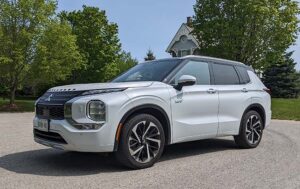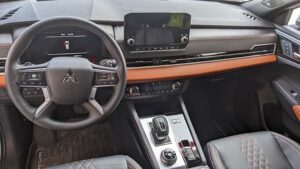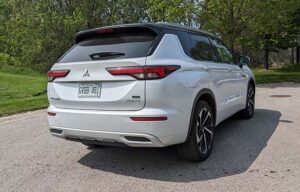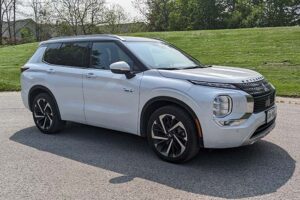2023 Mitsubishi Outlander PHEV SUV
All new for 2023, the Mitsubishi Outlander PHEV is a large 7 passenger SUV that straddles the line between full battery powered EV and a Hybrid powertrain vehicle. 
Mitsubishi has veered towards a more dramatic appearance to add some excitement to the Outlander. The front fascia now includes large torpedo tube-like LED light cavities in addition to a more discreet strip of LED headlights directly under the engine hood on each corner. Busy side panels flow backward to a less dramatic and clean rear liftgate. The styling was a bit overwhelming at first, but the design grew on me as it seemed less of a cookie cutter design on the road.
Our test vehicle was a top of the line GT model that was fully loaded with all the bells and whistles befitting a top range SUV. The interior of the Outlander is an elegant blend of contrasting leather and upscale synthetic surfaces with a large LCD touchscreen panel that dominates the centre of the dashboard. The only downside from a practical perspective was the highly reflective metal plate covering the shift console between the two front seats. The sunlight reflected during the midday hours was annoying.
 Rotary knobs at the lower corners of the screen intuitively interact with onscreen functions to adjust volume, audio levels and tuning the radio/SiriusXM channels. The instrument cluster behind the multifunction steering wheel is adaptable and displays speed and various other functions reported on by the onboard computer. It is an unconventional layout likened to waterwheels on either side of the instrument panel. The right side shows vehicle speed while left wheel is split to illustrate the electrical draw or regeneration on one half which is contrasted with engine RPM on the other. This display took me a bit of time to understand what I was looking at. While not the most intuitive design, the functions proved quite informative as the road test continued.
Rotary knobs at the lower corners of the screen intuitively interact with onscreen functions to adjust volume, audio levels and tuning the radio/SiriusXM channels. The instrument cluster behind the multifunction steering wheel is adaptable and displays speed and various other functions reported on by the onboard computer. It is an unconventional layout likened to waterwheels on either side of the instrument panel. The right side shows vehicle speed while left wheel is split to illustrate the electrical draw or regeneration on one half which is contrasted with engine RPM on the other. This display took me a bit of time to understand what I was looking at. While not the most intuitive design, the functions proved quite informative as the road test continued.
The Outlander powertrain consists of a 2.4L inline 4 cylinder gasoline engine paired with a 20 kWh battery, which is charged by either the plugin port or the alternator output from the combustion engine in the vehicle. The party trick somewhat unique to the Outlander is that it prefers to run as an all-electric drivetrain with the combustion engine relegated to the role of generator. However when extra power is needed, a driveline clutch engages the engine to add power to the front wheels. The Outlander PHEV offers all-wheel-drive without the weight of the driveshaft or transfer case/differential. Electric motors on the front and rear axles form what Mitsubishi calls AWC-S, their take on all-wheel-drive.
The drivetrain design is brilliant. With the onboard battery fully charged, fully electric range will usually exceed the 60 kms specified in the brochure. Consider the listed range a worst case scenario. When the ICE is called upon to feed the battery, it does so with barely noticeable intervention. The smoothness of the drivetrain design suggests this is a model that other manufacturers could do well to emulate.
Another highlight of the plugin hybrid design is the inclusion of a level 3 charging port in addition to the level 2 input. During the test period I was limited to using the 110V charger supplied with the vehicle while parked overnight and used level 3 chargers when available. The smaller battery allowed for quick top-ups using the level 3 chargers and proved that access to a home charger as not a prerequisite for PHEV ownership. In truth, I did not fill up the gas tank on this vehicle till the very end when I was returning it.
The Outlander PHEV has a number of powertrain management modes centred around battery charging options. Outside of the standard mode of using the battery first until it’s exhausted, drivers can choose to have the engine focus on replenishing the battery. A full battery comes in handy in parts of the world where emission free zones exist.
 Out on the road, the Outlander is genuinely fun to drive. Most are aware of the surge in acceleration that accompanies electric powertrains and although somewhat tempered in the Mitsubishi, there is still enough grunt to push the Outlander from 0-100 km/h in around 8 seconds. Ride quality and handling are a great blend of comfort and responsiveness. The Outlander maintains its composure in corners and over broken pavement. With 197mm ground clearance, no one will be tempted to take the Outlander off-roading, although for cottage roads the off-road setting controlling the AWD system should keep things on the straight and narrow.
Out on the road, the Outlander is genuinely fun to drive. Most are aware of the surge in acceleration that accompanies electric powertrains and although somewhat tempered in the Mitsubishi, there is still enough grunt to push the Outlander from 0-100 km/h in around 8 seconds. Ride quality and handling are a great blend of comfort and responsiveness. The Outlander maintains its composure in corners and over broken pavement. With 197mm ground clearance, no one will be tempted to take the Outlander off-roading, although for cottage roads the off-road setting controlling the AWD system should keep things on the straight and narrow.
The 2023 Mitsubishi Outlander replaces what had become the most popular model in the companies lineup. By adding extra range, extra seating and new dramatic styling, its little wonder the new model has retained is top selling status but the PHEV has now become the segment leader in sales both in Canada and around the world. Part of that attraction is a relatively approachable pricing structure. The gasoline only Outlander starts at $32,698 and the Outlander PHEV can be had for a little as $46,538. Our tester with the GT Premium package topped out at $59,598. In the current automotive landscape, Mitsubishi could sell the Outlander on price alone. However, The Outlander PHEV would likely earn its best selling status on the merit of the comfort, performance and the luxury offered in a very compelling package. Another point worth mentioning, Mitsubishi offers a 10 year warranty on the Outlander, significantly more than others in the Canadian marketplace. For full details on the 2023 Mitsubishi Outlander PHEV, please visit the Mitsubishi website.
Copyright © Auto Reviews Online 2016 | Privacy & Terms of Use | info@autoreviewsonline.com | Website by Brolly Media
